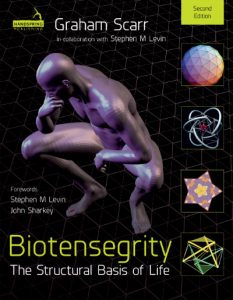Biotensegrity:
The Structural Basis of Life
The second edition of the book ‘Biotensegrity: the structural basis of life‘ – written in collaboration with Stephen Levin – is now available from Handspring and contains much information on the origins of tensegrity and the biotensegrity concept – the underlying principles and their implications for functional anatomy and biomechanics.
Biotensegrity is a structural principle that describes a relationship between every part of the organism and the mechanical system that integrates them into a complete functional unit. It is a conceptual model that represents a paradigm shift in biomechanical thinking and changes the way that we think about the complexities of functional anatomy.
The book answers the question ‘What is biotensegrity?’ and recognizes that all natural forms are the result of interactions between some basic principles of self-organization. It shows how an appreciation of these ‘rules’ leads to a better understanding of living organisms as functionally integrated and heterarchical units, and thus forms part of the basic science that underpins clinical reasoning.
Biotensegrity also fits with the ethos that unites a wide diversity of different practitioners and therapeutic methods because it intrinsically recognizes the wholeness of the human body. In other words, that an appreciation of the interconnectedness between every part of the organism is essential to a proper understanding of its functions, health and disease.
Biotensegrity has influenced the development of robots destined for the exploration of space and new classes of joint and prostheses with potential medical applications. It is also gaining momentum within the scientific community who examine the dynamic behaviour of cells and their interactions with the surrounding extracellular matrix and fascia, thus increasing our understanding of cancer and other illnesses. Biotensegrity underpins new ideas about joint mechanics and the global connectivity between these tissues and the nervous system, all of which operate synergistically in controlling movement and are far more than collections of anatomical ‘bits’. Where each ‘part’ is examined in relation to the whole and a more complete understanding obtained.
Super-stability
As this website and our understanding of the biotensegrity concept are constantly evolving, this section highlights a major new development in our understanding of the mathematical framework that underpins tensegrity architecture as the most energy-efficient (and thus most likely) structural system for biology – super-stability.
This was described in the 1998 by Connelly & Back but its importance to biotensegrity was only fully appreciated by Leonid Blyum in January 2020, at a small gathering in Washington DC with Stephen Levin, Susan Lowell de Solórzano and myself, and its implications are enormous.
The standard engineering approach to biomechanics is based on static determinacy and the solving of complex equations to understand motion, whereas the architecture of living organisms consists of “an incalculable number of endlessly transmutable and continuously reconfiguring… closed kinematic chain systems operating at multiple scale levels simultaneously” (Susan Lowell de Solórzano).
What this means is that because biology is kinematically indeterminate, inherently, any attempt to understand this ‘black box’ through standard biomechanical engineering methods will always be a gross misrepresentation, and that an algorithmic approach that considers the reality of the subject is destined to be more successful. ‘Biotensegrity is the super-stable hypothesis for biology’ and this was included in a presentation at the British Fascia Symposium in May 2022.

